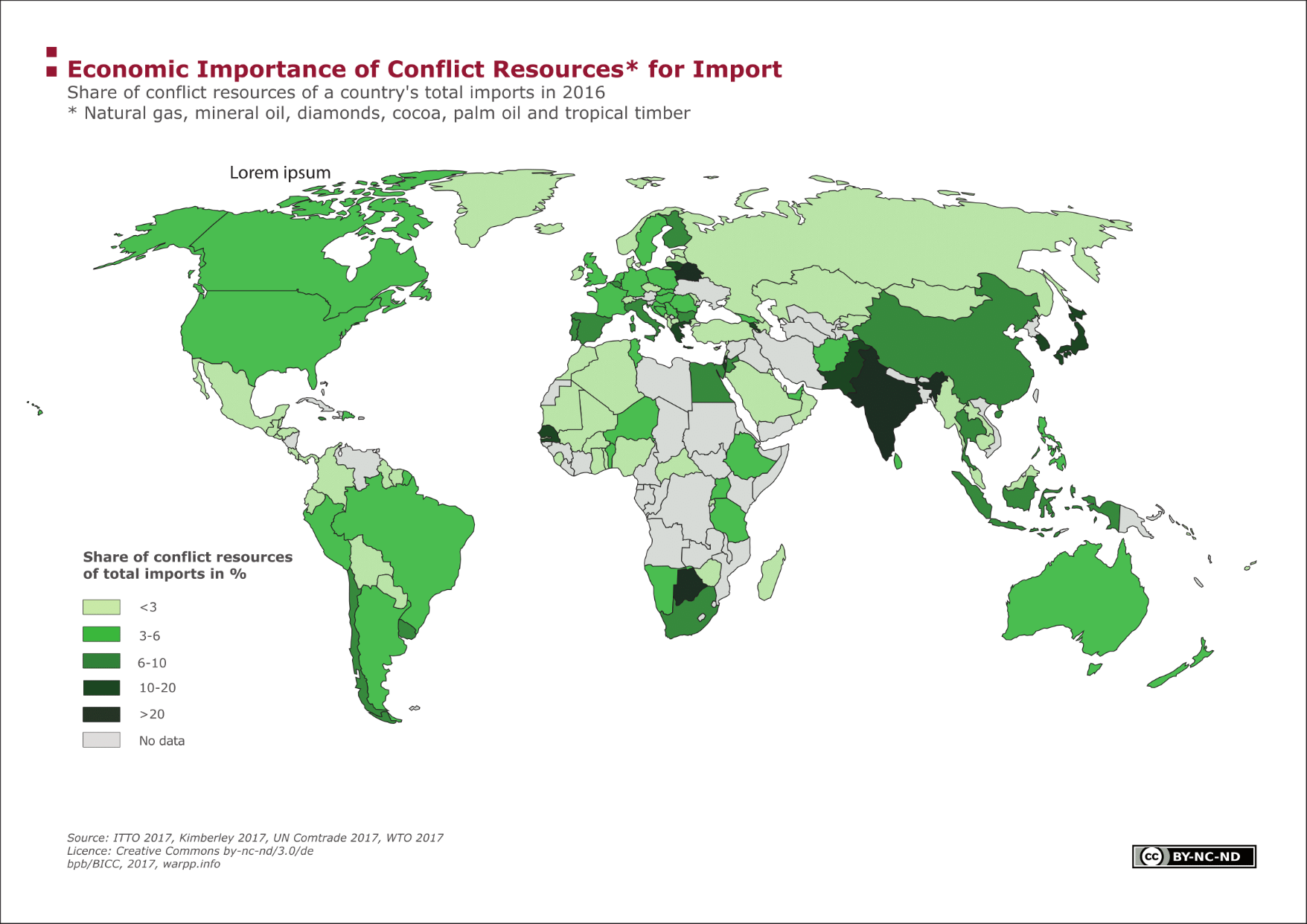Economic Importance of Conflict Resources for Import

The map shows the economic importance of the conflict resources crude oil, natural gas, diamonds, cocoa, palm oil and tropical wood as a percentage of a country's total import in 2016. The countries are divided into five classes for the purpose of comparison. The darker a country is colored, the greater the share of conflict minerals in the total import of the respective country.
Facts
Crude oil, natural gas, diamonds, cocoa, palm oil and tropical wood, so-called conflict minerals, are important export sources for many governments - especially developing countries. Conversely, for many economically developed countries and emerging economies, which are characterized by a strong manufacturing industry and a strong service sector, the import of these raw materials is very important because they often do not have them.
On the one hand, this is made very clear by the large number of developing countries, in which the import of these raw resources is of little importance and is therefore classified in the category very low. This is contrasted by the group of industrialized countries, such as the USA and many European countries, including Germany, France, Spain or Italy, which have a medium to high import share, and the group of emerging or transition countries, such as South Africa or India, which has a high to very high import share of these resource groups. Botswana, with a very high import share of diamonds, is a special case. Botswana itself is rich in diamond deposits and has developed a diamond-specialized and very one-sided mining, processing and trading industry.
Terms, notes on methodology or reading aids
How significant is the trade in conflict resources? This infographic relates the level of import revenues of conflict resources to the level of total import. The data used where published by the UN Comtrade, the International Tropical Timber Organization (ITTO), the Rough Diamond Statistic of the Kimberley Process and the data of the World Trade Organization (WTO). However, the import data available on the ITTO web page includes only the member countries. Countries that import tropical timber and are not members of the ITTO were therefore not included.
The map reads as follows: Nigeria belongs to the group of countries in which the share of conflict minerals crude oil, natural gas, diamonds, cocoa, palm oil and tropical wood accounts for more than 75% of total imports.
Detailed information on the respective share of the total import can be retrieved via the on-click event of the corresponding map layer in the module “natural resources and conflicts” of the Information Portal War and Peace (http://sicherheitspolitik.bpb.de).
Sources
ITTO - International Tropical Timber Organization The International Tropical Timber Organization is an international resource organization in which producers as well as importers of resources are organized. It exists since 1983 and is financed by voluntary donations. The ITTO is committed to the conservation and sustainable management, use and trading of tropical forest resources. Since 2006, a report on the status of Tropical Forest Management has been published annually, gathering information on the area and condition of tropical rainforests and their management. Several organizations criticize ITTO's data as saying that it is partly flawed and neither comprehensive nor up-to-date. In the absence of other freely available global datasets, this data will nevertheless be used at this point.
ITTO Annual Review Statistics Database
Kimberley Process The Kimberley Process or Kimberley Process Certification Scheme is an international effort by governments, corporations and civil society to stop trading with conflict diamonds. The KP was introduced in January 2003 and is supported by the United Nations. The system obliges the governments of diamond exporting countries to certify the origin of diamonds and to certify that they are not from conflict zones. Each rough diamond needs such a certificate of origin and can only be exported in member states of the KP. The diamond control regime is one of the few legally binding regulatory mechanisms for conflict minerals. The Kimberley Process now counts 54 participants (the 28 states of the European Union count as one participant). Member states submit half-yearly production data of rough diamonds and quarterly trade data three months after the reference period. The data are publicly available on the Kimberley Rough Diamond Statistic pages for the years 2004 onwards.
Kimberley Process Rough Diamond Statistics
UN Comtrade - United Nations Commodity Trade The UN Comtrade database provides detailed import and export statistics for more than 200 states and regions. The data is updated annually since 1962, making it one of the most comprehensive trade datasets worldwide .
WTO - World Trade Organization The World Trade Organization deals with trade and economic relations and was founded in 1994. Today it has 164 member states. Its main tasks are the removal of trade barriers and the liberalization of international trade. Trade data of various sources is collected, standardized and published by the organization annually. The data used in the calculation indicates the total import or export value of a country in US dollars.
WTO - Data For a detailed overview of the data and data sources, see: Module "Military Capacity and means" and the thematic group "Heavy Weapons Systems" with the two data levels "number of heavy weapons systems "and" number of heavy weapon systems per 10,000 inhabitants ".





